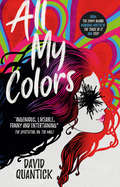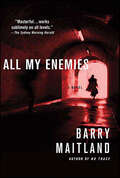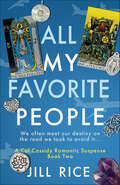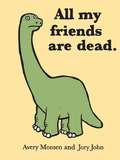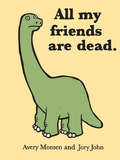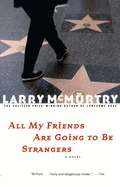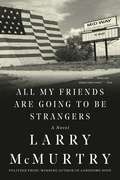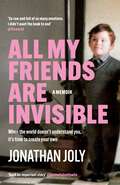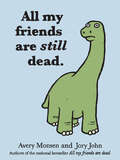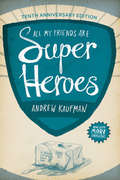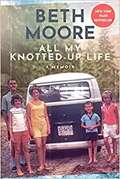- Table View
- List View
All My Best Friends
by David Fisher George BurnsThe author recalls how he and his young friends broke into vaudeville and made it to stardom on radio, in films and on TV. He laces his story with anecdotes about his fellow performers.
All My Bests
by Britnee MeiserIn the tradition of Hello, Goodbye, and Everything in Between, this smart and emotional romance told through playlists and memories follows two young teens struggling to hold onto each other as their friendship changes.Starting high school brings big changes for Immie and Jack, who&’ve been everything to each other ever since Jack crashed his skateboard into Immie&’s yard when they were seven years old. All of a sudden, a game-winning goal catapults Jack into star status with the soccer team, and Immie is meeting new girl friends whose questions are making her wonder about the identity of her father for the first time in her life. And amidst all of this, they&’re both realizing their feelings for each other might run deeper than they thought. Can their friendship—and the promise of something more—weather the storm that is growing up?
All My Bones Shake: Seeking a Progressive Path to the Prophetic Voice
by Robert JensenAt the root of the current political, economic, cultural, and ecological chaos is a national spiritual unrest, a fragmentation that has inhibited society's self-awareness and slowed theological progress to a glacial crawl.In a nation where three-fourths of the population identifies as Christian and religion salts the political discourse, unrest has manifested itself as the talking-head debate between atheists and believers. In All My Bones Shake, Robert Jensen reveals the multitiered complexity of the conflict and offers a progressive approach to its key theological questions. While fundamentalists on both sides have fought to an intellectual standstill and moderates seem content to ignore the battle, Jensen pushes for answers that make sense for anyone trying to exist in the modern scientific world, concluding, "There is no God, and more than ever we all need to serve the One True Gods."Jensen tests the mettle of his conclusion by holding it up to the best of religious and secular teachings. More than a simple study of the religious debate in America, All My Bones Shake marks a new communion: a way to use theology to create a sustainable society and meet the uncertainty of our lives with confidence.
All My Cats
by Bohumil HrabalA literary master’s story about the aggravations and great joys of cats, from “a most sophisticated novelist, with a gusting humor and a hushed tenderness of detail” (Julian Barnes) In the autumn of 1965, flush with the unexpected success of his first published books, the Czech author Bohumil Hrabal bought a cottage in Kersko. From then until his death in 1997, he divided his time between Prague and his country retreat, where he wrote and tended to a community of feral cats. Over the years, his relationship to cats grew deeper and more complex, becoming a measure of the pressures, both private and public, that impinged on his life as a writer. All My Cats, written in 1983 after a serious car accident, is a confessional memoir, the chronicle of an author who becomes overwhelmed. As he is driven to the brink of madness by the dilemmas created by his indulgent love for the animals, there are episodes of intense brutality as he controls the feline population. Yet in the end, All My Cats is a book about Hrabal’s relationship to nature, about the unlikely sources of redemption that come to him unbidden, like a gift from the cosmos—and about love.
All My Colors
by David QuantickFrom Emmy-award winning author David Quantick, All My Colors is a darkly comic novel about a man who remembers a book that may not exist, with dire consequences. A bizarre, mind-bending story at the intersection of Richard Bachman, Charlie Kaufman and Franz Kafka.It is March 1979 in DeKalb Illinois. Todd Milstead is a wannabe writer, a serial adulterer, and a jerk, only tolerated by his friends because he throws the best parties with the best booze. During one particular party, Todd is showing off his perfect recall, quoting poetry and literature word for word plucked from his eidetic memory. When he begins quoting from a book no one else seems to know, a novel called All My Colors, Todd is incredulous. He can quote it from cover to cover and yet it doesn't seem to exist.With a looming divorce and mounting financial worries, Todd finally tries to write a novel, with the vague idea of making money from his talent. The only problem is he can't write. But the book - All My Colors - is there in his head. Todd makes a decision: he will "write" this book that nobody but him can remember. After all, if nobody's heard of it, how can he get into trouble?As the dire consequences of his actions come home to both Todd and his long-suffering friends, it becomes clear that there is a high - and painful - price to pay for his crime.
All My Daughters
by Barbara DelinskyFrom the New York Times best-selling author of More Than Friends and Suddenly comes this touching novel of the many facets and the enduring power of love, the tenadous strength of family, and the choices we make that determine who we are. With a voice as true as our own, Barbara Delinsky tells the story of the St. Clair sisters, whose wealthy, social-climbing mother, Virginia, had little time-and even less feeling-for them. Now adults, the three women have spent their lives trying to escape Virginia's legacy. Caroline, a tough lawyer, has sacrificed much to gain the control she craves above all else. Annette finds great happiness in showering her husband and five children with the kind of love she herself never received. Leah's search for love has led to a life that is somehow filled with nonstop activity and empty at the same time. And while the sisters consider themselves happy, each has lost a part of herself she doesn't even miss.. .one for which the soul aches nonetheless. Then the letters come. It seems that Virginia has a favor to ask of her daughters. She wants them to help her get settled into Star's End, her magnificent new house on the peaceful, wind-blown coast of Maine. We haven't been close, she writes. I'd like to try to rectify that. It would be nice to spend time together. We might talk. Though their first reaction is to turn her down, each of the sisters ultimately decides to go.. .to give to Virginia, for perhaps the last time, that which she asks of them. But it is Virginia who gives to her daughters For amid the glorious beauty of a New England summer, Caroline, Annette, and Leah find answers to questions that have troubled them for years, insights into the men in their lives, and new truths that will stay with them forever.
All My Desire
by Margaret MooreWhen a bold knight kidnaps the wrong lady, he ends up with more than he bargained for in this passionate, exciting love story from the pen of a most talented writer.
All My Enemies: A Brock and Kolla Mystery (Brock and Kolla Mysteries)
by Barry MaitlandIn one of the finest and most pivotal books in this critically acclaimed series, never before published in the U.S., D.S. Kathy Kolla reports to New Scotland Yard and to D.C.I. David Brock's Serious Crime Division. Just before Kolla is to start her new job, a young woman is found viscously murdered in a leafy, well-heeled suburb, and the grotesque details of the slaughter appear to be well-rehearsed, even theatrical. Assigned to the case, Kolla's only improbable lead draws her to a local amateur drama group. Once in their orbit, she is lured into a piece of theatre over which, increasingly, she has little control. In All My Enemies, Brock and Kolla find themselves in a tangled web of deceptions in a case wherein a corpus of plays becomes a template for murder.
All My Favorite People (Cal Cassidy Romantic Suspense)
by Jill RiceWe often meet our destiny on the road we take to avoid it. When Eve Gardner was seventeen, she bought a bus ticket to California. The life her parents planned for her was nothing like the life she wanted. She wanted to be as far away from her parents as a road could take her. In less than a month, she had a new name, “Eva,” a new husband, and even a new country. Álvaro Castillo, the accountant for a dangerous drug cartel, had his own reasons for being on that bus. He was on the run, having just killed the man who threatened to expose him as an undercover DEA. The life Álvaro and Eva create in Taxco, Mexico, is a dream come true for both. When a famous silversmith takes her under his wing, Eva becomes a successful jeweler in her own right. As she works with force and fire to shape silver into her stunning jewelry designs, Eva comes to understand the process is akin to the alchemy of the human soul. The question of destiny looms large in her life: did she run away from her fate when she left Atlanta, or did she run headlong into the life she was meant to live? When their son, Azul, is born Álvaro and Eva believe they have reached the pinnacle of happiness. They were mistaken. The cartel put a three-million-dollar bounty on Álvaro’s head and one day an old enemy comes to collect it. The action Eva takes to keep Azul safe jeopardizes her marriage and her happiness. Álvaro cannot forgive her for sending their son to the family Eva abandoned twenty-six years ago. Eva examines her old beliefs and past actions after she is reunited with her family in Atlanta. When she and her mother are kidnapped by the cartel as revenge for Alvaro’s betrayal, they must reconcile and unite to stay alive. Together they use their wits and a little bit of magic to navigate their capture and eventual release. When devastating family secrets come to light, love can redeem the past if they will let it.
All My Fortunes
by Katie FlynnAn epic love story set in England and Russia in the 1930s as two people overcome unbelievable hardship to be together from bestselling author Katie Flynn‘Take care of Eva.’These words are all that remain of Pavel Fedorovna’s former life, though she can no longer remember who said them. All she knows is that they marked the end of life as she knew it - and a new beginning in the Russian Caucasus.Meanwhile on Deeside, young David Thomas's carefree existence is torn apart by a shipping tragedy which will colour his whole life.A decade later David, now an engineer and working in Russia, meets the young Pavel, just as she is emerging into womanhood. But Russia in the 1930s is no place for young lovers and the story of their struggle to be together is a powerful tale of emotion, adventure, unbelievable hardship and ultimate triumph.
All My Friends Are Dead
by Jory John Avery MonsenIf you're a dinosaur, all of your friends are dead. If you're a pirate, all of your friends have scurvy. If you're a tree, all of your friends are end tables. Each page of this laugh-out-loud illustrated humor book showcases the downside of being everything from a clown to a cassette tape to a zombie. Cute and dark all at once, this hilarious children's book for adults teaches valuable lessons about life while exploring each cartoon character's unique grievance and wide-eyed predicament. From the sock whose only friends have gone missing to the houseplant whose friends are being slowly killed by irresponsible plant owners (like you), All My Friends Are Dead presents a delightful primer for laughing at the inevitable.
All My Friends Are Dead
by Jory John Avery Monsen<p>If you're a dinosaur, all of your friends are dead. If you're a pirate, all of your friends have scurvy. If you're a tree, all of your friends are end tables. Each page of this laugh-out-loud illustrated humor book showcases the downside of being everything from a clown to a cassette tape to a zombie. <p>Cute and dark all at once, this hilarious children's book for adults teaches valuable lessons about life while exploring each cartoon character's unique grievance and wide-eyed predicament. From the sock whose only friends have gone missing to the houseplant whose friends are being slowly killed by irresponsible plant owners (like you), All My Friends Are Dead presents a delightful primer for laughing at the inevitable. <p>This is a fixed-format ebook, which preserves the design and layout of the original print book.</p>
All My Friends Are Fast Asleep
by David WeinstoneParents Magazine's "Best Bedtime Story" of 2017!From David Weinstone, the popular children's musician and creator of the Music for Aardvarks program, comes All My Friends Are Fast Asleep, a rhythmic, cheerily illustrated bedtime story sure to smooth the way to sleep for young insomniacs everywhere.After tossing and turning in his bed, a little boy embarks on a nighttime quest to find a cozy place to rest. He visits one animal friend after another, from a lark in its nest to a mole in its hole. But while all the animals he meets are happily dozing off, this tuckered-out wanderer remains wide-awake—until he finally finds the perfect spot to lay his head.
All My Friends Are Going to Be Strangers
by Larry McmurtryLarry McMurtry's portrait of the artist as a young man: on a wild ride towards literary fame, and leaving behind everyone he deeply loves...
All My Friends Are Going to Be Strangers: A Novel
by Larry McMurtryA young writer hits the dusty Texas highway for the California coast in this “brilliant . . . funny and dangerously tender” (Time) tale of art and sacrifice. Hailed as one of “the best novels ever set in America’s fourth largest city” (Douglas Brinkley, New York Times Book Review), All My Friends Are Going to Be Strangers is a powerful demonstration of Larry McMurtry’s “comic genius, his ability to render a sense of landscape, and interior intellection tension” (Jim Harrison, New York Times Book Review). Desperate to break from the “mundane happiness” of Houston, budding writer Danny Deck hops in his car, “El Chevy,” bound for the West Coast on a road trip filled with broken hearts and bleak realities of the artistic life. A cast of unforgettable characters joins the naive troubadour’s pilgrimage to California and back to Texas, including a cruel, long-legged beauty; an appealing screenwriter; a randy college professor; and a genuine if painfully “normal” friend. Since the novel’s publication in 1972, Danny Deck has “been far more successful at getting loved by readers than he ever was at getting loved by the women in his life” (McMurtry), a testament to the author’s incomparable talent for capturing the essential tragicomedy of the human experience.
All My Friends Are Invisible
by Jonathan Joly*A mesmeric, harrowing and uplifting childhood memoir that will open up much-needed conversations about identity and mental health*'An extraordinary and thought-provoking memoir' - Belfast TelegraphIt was an ordinary day in 2016. In Gatwick Airport, Jonathan and his wife Anna were having breakfast with their two little children while waiting for their flight to be called. And then it happened, a familiar sensation that Jonathan hadn't had for decades: an out-of-body experience that transported him to another place, the safe place he used to escape to in his mind when he was a boy. Because growing up in conservative 1980s Dublin, where there was little tolerance for children who were 'different', Jonathan Joly was, indeed, a different sort of child: creative, expressive, and - on the inside - a girl. The limitations of the people around him to understand his differences led to years of tyrannical bullying and abuse, forcing him to withdraw within himself to the point of clinical absence. His only chance for survival was the inner world he created for himself, rich with loving and supportive friends and playmates, that only he could see. Jonathan's invisible friends were his lifeline, and on that day at the airport, they came flooding back, and have remained with him to this day. This extraordinary childhood memoir is not only an important, thought-provoking and exhilarating read, it gives hope and community for all those who have ever felt 'other', and proves how vital it is to provide children with the safe space to be themselves. In All My Friends are Invisible, Jonathan Joly, known widely as one of social media's most successful content creators, shares the secret he's kept hidden these many years. He shows the beautiful world he retreated to time and time again when life was unbearable for his 'skin machine'. Most importantly, he introduces us to his invisible friends, and in so doing you may be transported back to the friends you had as a child that no one else could see, and who may have saved you, too. "When you find yourself living in a world that doesn't understand you, and you lack any connection to anyone or any place, you are faced with few options. You can choose to leave this world and hope whatever lies beyond ends up being better, or you can create your own. It will require grit, hardship, pain and suffering, but the rewards will be great, and the journey will be greater, and the adventures will be endless. So, at a very young age and faced with these options, I chose the latter." All My Friends are Invisible will be one of the most talked about books of 2022.
All My Friends Are Invisible
by Jonathan Joly*A mesmeric, harrowing and uplifting childhood memoir that will open up much-needed conversations about identity and mental health*'This will blow you away'- Stylist'An extraordinary and thought-provoking memoir' - Belfast Telegraph'Gives hope and community for all those who have ever felt "other", and proves how vital it is to provide children with the safe space to be themselves' - Irish ExaminerIt was an ordinary day in 2016. In Gatwick Airport, Jonathan and his wife Anna were having breakfast with their two little children while waiting for their flight to be called. And then it happened, a familiar sensation that Jonathan hadn't had for decades: an out-of-body experience that transported him to another place, the safe place he used to escape to in his mind when he was a boy. Because growing up in conservative 1980s Dublin, where there was little tolerance for children who were 'different', Jonathan Joly was, indeed, a different sort of child: creative, expressive, and - on the inside - a girl. The limitations of the people around him to understand his differences led to years of tyrannical bullying and abuse, forcing him to withdraw within himself to the point of clinical absence. His only chance for survival was the inner world he created for himself, rich with loving and supportive friends and playmates, that only he could see. Jonathan's invisible friends were his lifeline, and on that day at the airport, they came flooding back, and have remained with him to this day. This extraordinary childhood memoir is not only an important, thought-provoking and exhilarating read, it gives hope and community for all those who have ever felt 'other', and proves how vital it is to provide children with the safe space to be themselves. In All My Friends are Invisible, Jonathan Joly, known widely as one of social media's most successful content creators, shares the secret he's kept hidden these many years. He shows the beautiful world he retreated to time and time again when life was unbearable for his 'skin machine'. Most importantly, he introduces us to his invisible friends, and in so doing you may be transported back to the friends you had as a child that no one else could see, and who may have saved you, too. "When you find yourself living in a world that doesn't understand you, and you lack any connection to anyone or any place, you are faced with few options. You can choose to leave this world and hope whatever lies beyond ends up being better, or you can create your own. It will require grit, hardship, pain and suffering, but the rewards will be great, and the journey will be greater, and the adventures will be endless. So, at a very young age and faced with these options, I chose the latter." All My Friends are Invisible will be one of the most talked about books of 2022.
All My Friends Are Invisible: the inspirational childhood memoir
by Jonathan Joly*A mesmeric, harrowing and uplifting childhood memoir that will open up much-needed conversations about identity and mental health*It was an ordinary day in 2016. In Gatwick Airport, Jonathan and his wife Anna were having breakfast with their two little children while waiting for their flight to be called. And then it happened, a familiar sensation that Jonathan hadn't had for decades: an out-of-body experience that transported him to another place, the safe place he used to escape to in his mind when he was a boy. Because growing up in conservative 1980s Dublin, where there was little tolerance for children who were 'different', Jonathan Joly was, indeed, a different sort of child: creative, expressive, and - on the inside - a girl. The limitations of the people around him to understand his differences led to years of tyrannical bullying and abuse, forcing him to withdraw within himself to the point of clinical absence. His only chance for survival was the inner world he created for himself, rich with loving and supportive friends and playmates, that only he could see. Jonathan's invisible friends were his lifeline, and on that day at the airport, they came flooding back, and have remained with him to this day. This extraordinary childhood memoir is not only an important, thought-provoking and exhilarating read, it gives hope and community for all those who have ever felt 'other', and proves how vital it is to provide children with the safe space to be themselves. In All My Friends are Invisible, Jonathan Joly, known widely as one of social media's most successful content creators, shares the secret he's kept hidden these many years. He shows the beautiful world he retreated to time and time again when life was unbearable for his 'skin machine'. Most importantly, he introduces us to his invisible friends, and in so doing you may be transported back to the friends you had as a child that no one else could see, and who may have saved you, too. "When you find yourself living in a world that doesn't understand you, and you lack any connection to anyone or any place, you are faced with few options. You can choose to leave this world and hope whatever lies beyond ends up being better, or you can create your own. It will require grit, hardship, pain and suffering, but the rewards will be great, and the journey will be greater, and the adventures will be endless. So, at a very young age and faced with these options, I chose the latter." All My Friends are Invisible will be one of the most talked about books of 2022.(P) 2022 Quercus Editions Limited
All My Friends Are Still Dead
by Jory John Avery MonsenFrom the authors of the breakout best seller All my friends are dead comes a brand-new illustrated compendium of the humorous existential ruminations of people, animals, legendary monsters, and inanimate objects.
All My Friends Are Superheroes
by Andrew KaufmanAll Tom's friends really are superheroes. There's the Ear, the Spooner, the Impossible Man. Tom even married a superhero, the Perfectionist. But at their wedding, the Perfectionist was hypnotized (by ex-boyfriend Hypno, of course) to believe that Tom is invisible. Nothing he does can make her see him. Six months later, she's sure that Tom has abandoned her. So she's moving to Vancouver. She'll use her superpower to make Vancouver perfect and leave all the heartbreak in Toronto. With no idea Tom's beside her, she boards an airplane in Toronto. Tom has until the wheels touch the ground in Vancouver to convince her he's visible, or he loses her forever.
All My Friends Are Superheroes
by Tom Percival Andrew KaufmanAll Tom's friends really are superheroes. There's the Ear, the Spooner, the Impossible Man. Tom even married a superhero, the Perfectionist. But at their wedding, the Perfectionist was hypnotized (by ex-boyfriend Hypno, of course) to believe that Tom is invisible. Nothing he does can make her see him. Six months later, she's sure that Tom has abandoned her. So she's moving to Vancouver. She'll use her superpower to make Vancouver perfect and leave all the heartbreak in Toronto. With no idea Tom's beside her, she boards an airplane. Tom has until the wheels touch the ground in Vancouver to convince her he's visible, or he loses her forever. The tenth anniversary edition of Andrew Kaufman's perennial favourite, All My Friends Are Superheroes, includes a new catalogue of superheroes and gorgeous illustrations by Tom Percival.
All My Friends Have Issues: Building Remarkable Relationships with Imperfect People (Like Me)
by Amanda AndersonWhy is it so challenging to create and keep meaningful friendships?Amanda Anderson provides the wise and witty answers, giving practical advice and sharing personal stories to guide us toward the kinds of friendships we long for. Blending faith-based insights and psychological truths, All My Friends Have Issues is a liberating guide to finding and becoming an authentic and encouraging friend. “Anderson becomes the friend we’ve always needed and, in the process, helps us become a better friend.”—Elisa Morgan, president emerita of MOPS International, speaker, and author of The Beauty of Broken“Be ready to laugh and then to learn as Amanda shares her weaknesses and foibles in her relationships with herself and her friends.”—David Stoop, PhD, clinical psychologist and author of You Are What You Think “A captivating and often hilarious book.”—Milan and Kay Yerkovich, authors of How We Love and How We Love Our Kids “Fun and informative. . . . A book I highly recommend!”—Debbie Alsdorf, speaker and author of It’s Momplicated and The Faith Dare“Warm, funny, authentic, and relatable.”—Vivian Mabuni, speaker and author of Open Hands, Willing Heart
All My Friends Live in My Computer: Trauma, Tactical Media, and Meaning
by Samira RajabiAll My Friends Live in my Computer combines personal stories, media studies, and interdisciplinary theories to examine case studies from three unique parts of society. From illness narratives among breast cancer patients to political upheaval among Iranian-Americans, this book examines what people do when they go online after they have suffered a trauma. It offers in-depth academic analysis alongside deeply personal stories and case studies to take the reader on a journey through rapidly changing digital/social worlds. When people are traumatized, their worlds stop making sense, and All My Friends Live in my Computer explores how everyday people use social media to try and make a new world for themselves and others who are suffering. Through its attention to personal stories and application of media theory to new contexts, this book highlights how, when given the tools, people will make meaning in creative, novel, and healing ways.
All My Knotted-Up Life: A Memoir
by Beth MooreAn incredibly thoughtful, disarmingly funny, and intensely vulnerable glimpse into the life and ministry of a woman familiar to many but known by few. “It’s a peculiar thing, this having lived long enough to take a good look back. We go from knowing each other better than we know ourselves to barely sure if we know each other at all, to precisely sure that we don’t. All my knotted-up life I’ve longed for the sanity and simplicity of knowing who’s good and who’s bad. I’ve wanted to know this about myself as much as anyone. This was not theological. It was strictly relational. God could do what he wanted with eternity. I was just trying to make it here in the meantime. As benevolent as he has been in a myriad of ways, God has remained aloof on this uncomplicated request.”
All My Lies
by Sophie Flynn'Perfectly paced, suspenseful and gripping - a real page-turner' SOPHIE HANNAH, author of Haven't They Grown 'A rollercoaster ride with a cast of flawed characters - an excellent debut from Sophie Flynn' CATHERINE COOPER, author of The Chalet &‘A twisty, intense and emotional story with suspense on every page' TM LOGAN, author of The Holiday and Trust MeAnna wants to escape. She doesn&’t know when her marriage to James began to feel like a trap or when he became so controlling. All she knows is that she needs to leave before it&’s too late. And she has a plan. When Anna reconnects with her childhood sweetheart, Sam, she sees it as the answer to her problems. Finally, they&’ll have a life together, like they&’d always planned – the life she was meant to have. But the lies are catching up with her . . . On the morning of their escape, Sam goes missing. Anna knows he wouldn&’t leave her, that something must have happened to him. Her search for answers will force her to confront her past, something that she has been running from for a very long time . . . Perfect for fans of Louise Jensen, Phoebe Morgan and K.L. Slater, this is a twisty, tense psychological thriller about one woman&’s hunt for the truth and her ultimate fight to break free. Praise for All My Lies 'I raced through All My Lies in a single weekend . . . I barely paused for breath until the final page. A must read' HOLLY SEDDON, author of The Hit List 'A fantastic debut that showcases how blind love can make us. Sophie Flynn has written a brilliant book that sucks the reader in and keeps them guessing throughout' S.V. LEONARD, author of The Islanders 'A fresh new voice in psychological suspense. All My Lies is an assured debut and has all the right ingredients for fans of the genre. Great characters, evocative writing, interesting locations and a page-turning plot with plenty of twists and turns. I can&’t wait to see where Flynn goes next!' SARAH LINLEY, author of The Trip 'I raced through this book, reading well into the early hours of the morning. Original, bold and highly compelling, this is a book that will stay with readers for a long time. It heralds the arrival of an exceptionally talented voice in crime fiction. A riveting debut!' AWAIS KHAN, author of No Honour 'A thrilling new voice - Sophie Flynn pulls the reader in with believable, strong characters and an explosive plot' AMANDA BRITTANY, author of The Perfect Nanny




